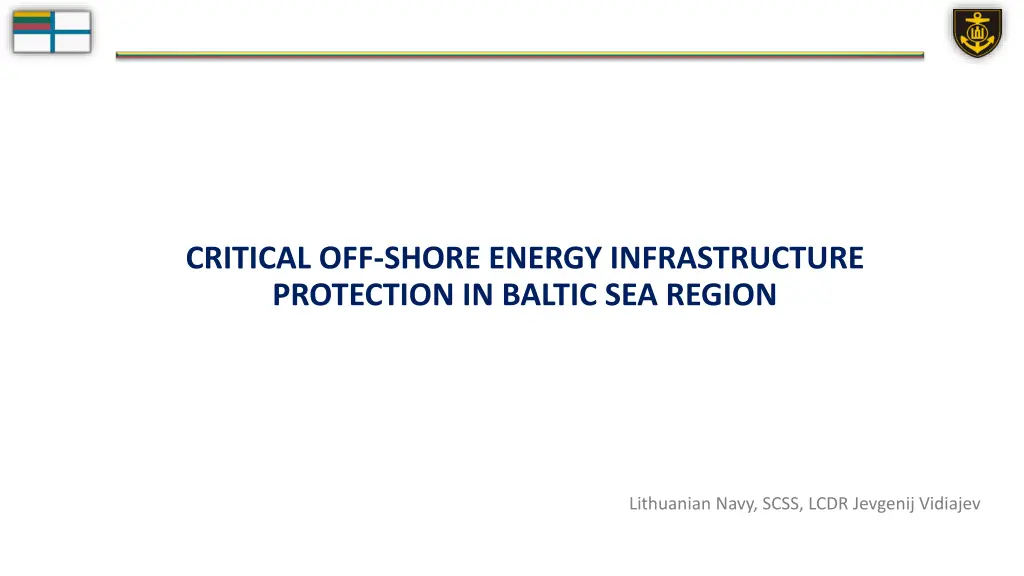
Baltic Sea Energy Infrastructure Protection
"Explore the critical vulnerabilities and legal aspects of protecting energy infrastructure in the Baltic Sea region. Discover findings from the COHERENT RESILIENCE 2023 Exercise, including priorities for enhancing security and cooperation arrangements. Learn about new mindsets and preparedness strategies to safeguard against potential threats and ensure the resilience of energy infrastructure. Gain insights into territorial sea rights, exclusive economic zones, and the challenges of offshore protection in the Baltic Sea environment."
Download Presentation

Please find below an Image/Link to download the presentation.
The content on the website is provided AS IS for your information and personal use only. It may not be sold, licensed, or shared on other websites without obtaining consent from the author. If you encounter any issues during the download, it is possible that the publisher has removed the file from their server.
You are allowed to download the files provided on this website for personal or commercial use, subject to the condition that they are used lawfully. All files are the property of their respective owners.
The content on the website is provided AS IS for your information and personal use only. It may not be sold, licensed, or shared on other websites without obtaining consent from the author.
E N D
Presentation Transcript
CRITICAL OFF-SHORE ENERGY INFRASTRUCTURE PROTECTION IN BALTIC SEA REGION Lithuanian Navy, SCSS, LCDR Jevgenij Vidiajev
AGENDA Infrastructure vulnerabilities Baltic Sea environment and trends COHERENT RESILIENCE 2023 Exercise findings Legal aspects Critical energy infrastructure protection in Lithuania (Maritime domain)
INFRASTRUCTURE VULNERABILITIES PEACE CRISIS WAR Natural disasters (hurricanes, floods etc.) Human factor (anchor dragging, fishing trawlers, unlawful actions) Technical issues (windmill crash, fires etc.) Terrorism Non-friendly state actors (hidden actions) War related actions LAW ENFORCEMENT ENTITIES ARMED FORCES (NAVY, AIR FORCE) INFRASTRUCTURE OPERATORS
ENVIRONMENT & TRENDS Rapid expansion of energy infrastructure in Baltic Sea region Russian EU/NATO tension High economic activity (traffic density) Historical heritage (mines, chemical weapon dumping grounds) Mines
COHERENT RESILIENCE 2023 Ex FINDINGS Energy infrastructure vulnerable Attack surface too wide to protect everything Identify critical energy infrastructure protection priorities Quick and secure communications between operators and security actors Operators have limited authority to enhance security
COHERENT RESILIENCE 2023 TAKE AWAYS New mindsets that build-in security and protection of energy infrastructure from the outset Preparedness is key. Frameworks, plans and points of contact Roles and responsibilities clear Identification and detection. Surveillance and monitoring Understand the threat. Identify necessary capabilities. Ensure authorities Cooperation arrangements between operators and governments through peacetime, crisis and conflict
LEGAL ASPECTS Territorial Sea 12nm from a coastal State s baselines Sovereignty of the coastal State (!! Innocent passage of other States) 24/7 surveillance + authority Exclusive Economic Zone Up to 200 nm from a coastal State s baselines Sovereign rights relating to: construct and operate artificial installations and structures, as well as establishing safety zones to protect them (500 m.) (Art. 60 UNCLOS) NOT submarine cables and pipelines passing through a coastal State s EEZ (only the flag State, Art. 113 UNCLOS) LESS surveillance + LESS authority + LESS assetts able to operate off shore
CRITICAL ENERGY INFRASTRUCTURE PROTECTION IN LTU INTERNATIONAL PARTNERS Physical protection/Monitoring Operators OPERATORS COORDINATION Security/Policing Government entities CONSTABULARY ENTITIES STANDING PLANS MARITIME SITUATIONAL AWARENESS Defense Naval FORCES ALLIES AND PARTNERS
